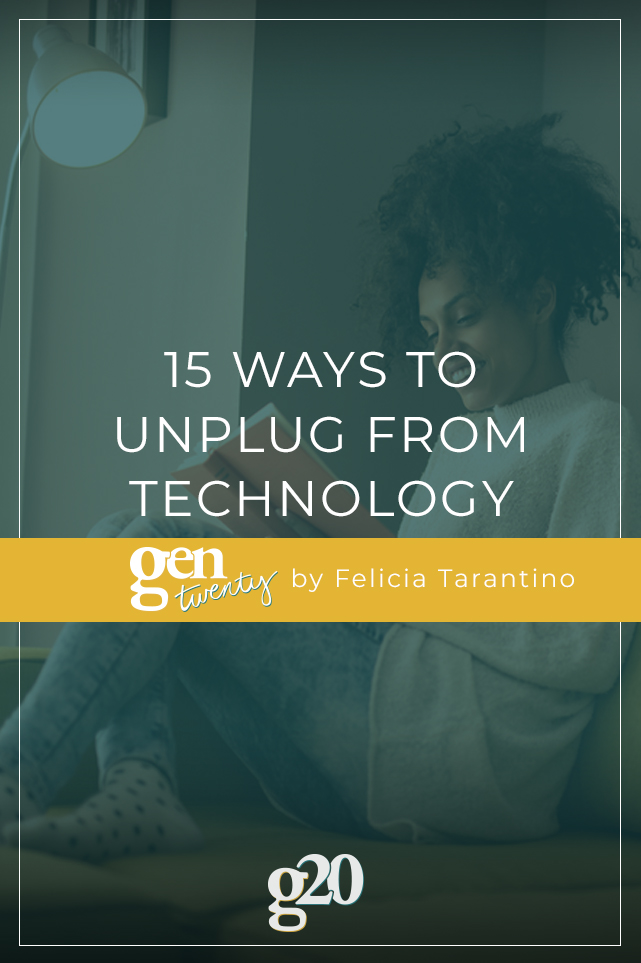Did you know the National Day of Unplugging this year is March 4, 2022?
There’s no doubt that technology has made an improvement to the everyday lives of humans. But sometimes, it’s definitely a good idea to take a break from our phones.
If you’re like me, this pandemic has forced you to spend way more time online. Whether it be checking in with family through Zoom calls or working from home, technology currently plays a huge role in our lives. But too much technology can definitely be draining and even bad for your mental or physical health.
When was the last time you truly unplugged? A break from screens is needed and, let’s be honest, most of us could be using our screens more intentionally. We tend to unplug when we’re on vacation, but let this post encourage you not to wait until your next vacation to unplug, set limits, and embrace your free time away from electronic media.
For the National Day of Unplugging, we’re sharing 15 ways that you can unplug from technology when you need to take a break!
This post may contains affiliate links.
15 Ways to Unplug From Technology When You Need to Chill
1. Put away your phone an hour before bed.
Do you have trouble falling asleep? According to recent studies, the cause might be your cell phone. The blue light emitting from the screen of mobile phones actually upsets your circadian rhythm, among other issues. The bottom line: too much screen time can get in the way of a good night’s sleep.
So it goes without saying that it probably isn’t the best idea to scroll through your TikTok FYP for hours in bed.
Instead, try to put your phone away at least an hour before you go to sleep. If you can’t fall asleep straight away, try reading a book in bed.
Here are some tips that might help you set up a better nighttime routine:
- 10 Evening Routine Ideas for a Peaceful Night
- Creating a Nightly Routine for Less Stress and More Calm

2. Set up a docking station in your home.
If you find yourself often reaching for your phone when you’re at home, you might want to consider setting up a docking station. This is a place where you leave your phone every day instead of carrying it around the house with you.
By creating a home for your phone, you’re less likely to mindlessly grab for it throughout the day. It forces you to be more intentional with your digital screen time. This is a good thing!
3. Make use of your phone’s app limits.
By now, most iPhone users are aware that their phones come with an internal tracking system that logs how much time they spend on their phones. But did you know that you can use this function to restrict how much time you’re using your phone?
The Screen Time settings on iPhones allow you to set a number of restrictions and set limits such as downtime, app limits, communication limits, and more. This is a great way to force yourself to get off your phone by setting reminders and limitations on your use.
Here are five apps some app suggestions you might find helpful:
4. Carry a book with you.
A lot of people use their cell phones more often in public when they’re forced into awkward social situations. Before cell phones, we had magazines and newspapers to keep us entertained. Now, people reach for their phones.
If you’re guilty of this but want to unplug more often, try carrying a book with you to appointments or on your commute. Instead of reaching for your cell phone to scroll through social media, you can get in a few chapters of reading while waiting.
5. Take a walk without your phone.
It’s safe to say that excessive screen time can make you feel a little bit out of touch with the world around you. We sure feel this way too sometimes! It’s especially difficult when our lives have been consumed by digital interaction these past few years.
The best remedy is by getting out into nature. Leave your phone behind and go take a walk. Whether it’s a 30-minute stroll around the neighborhood or a hike on a trail, it’s a huge boost to your wellbeing to spend some time in the great outdoors.

6. Invest in quality face-to-face time with loved ones.
Throughout the pandemic, we have seen a major increase in online socialization. We’ve become pros at using Zoom or Facetime, and we spend more time texting our friends and family than we do seeing them.
With the restrictions lifting in many places, this is a great opportunity to see your loved ones in person, if possible. Even just a socially distanced visit outside with your friends or family members can help you connect on a much deeper level than through a screen. That quality time is truly invaluable.
7. Take up a new non-digital hobby.
Something that a lot of young people struggle with these days is finding a hobby. In this day and age, hobbies have largely been redubbed “side hustles”. Many people don’t even bother trying out a new hobby unless they’re skilled at it and able to monetize it.
However, taking up a hobby that doesn’t include your phone, TV or computer can be great for your mental health. It can be as complex as painting or knitting, or as basic as putting together a puzzle or playing board games (and maybe not video games). Whatever it is, take time aside a couple of days a week to disconnect and enjoy a peaceful activity.
8. Start journaling.
Journaling has so many benefits for your mental health and wellbeing. It allows you to get in touch with your inner emotions, and even just provides an opportunity to vent about things without feeling any reservations.
Journaling can also be a great way to step away from your screen for a bit and get in touch with yourself. It’s easy to become overwhelmed and even lose yourself by spending too much time online. Journaling gives you the opportunity to engage with your thoughts in a productive way and it is a powerful tool for mental health.
More on journaling:
- What Is A Junk Journal?
- 70 Therapy Journal Prompts for Personal Growth
- How to Add a Journaling Practice to Your Routine
- The 8 Best Journals For Self-Care
9. Go on an adventure.
One of the biggest reasons why we turn to our digital products is boredom. When we run out of things to do or chores to complete, we aren’t always sure what to do with the extra hours in a day. So why not go on an adventure to keep yourself busy and away from your phone?
If you’re looking for something to do outside of the home, try becoming a tourist in your own city. Check out the local shops and cafes. If you have a bit more time on your hands, you might consider taking a day trip to another town or city, and seeing what they have to offer! The fresh air will do you good.

10. Turn off your notifications.
The best way to minimize distractions from technology is by removing them altogether. The constant buzzing of your cell phone is definitely not helping you to put some healthy space between you and the digital world.
Try disabling your notifications when you are able to. Turn off all notifications for social media apps so that they don’t notify you of every tweet or post. Are you super guilty of answering Slack messages when you’re off the clock? I totally am. Try snoozing your work notifications or turning your “Do Not Disturb” function when possible.
Do this for both personal things and social media platforms as well as work things, like your work email. Your mind doesn’t need your phone to ping you all the time.
11. Be more intentional in your in-person conversations.
I think all of us are guilty of having impersonal conversations a lot—if not most—of the time. Small talk has really consumed us, especially in workplace scenarios or other social situations where we feel out of place. In a lot of these situations, we actually use cell phones to avoid having to have conversations.
If you’re looking to unplug, try having more intentional conversations with others. This could mean going to a cafe with a friend and having a long catch-up without your phone, or maybe it means having dinner at home with your partner without turning the TV on.
12. Set zones and/or times that are technology-free.
If you’re really looking to make a big change to the way that you use technology in your daily life, try setting up technology-free zones in your home or times throughout the day.
For instance, you could make your bedroom a technology-free zone, meaning that you never bring a cell phone in or you remove your TV from the wall. If it’s more difficult for you to entirely remove technology, you can try setting times each day where you don’t use technology. Start off small and spend an hour a day not using anything digital. It’ll make a huge difference!
13. Reduce your technology use 10% at a time.
Going from “all the time” to “none of the time” isn’t a particularly realistic goal to set when it comes to our technology use. It’s very intertwined with our everyday lives, right? So the recommendation here is to check your screen time use and aim to use your phone or device 10% less the next week.
So say you used your phone for five hours a day. The next week you’d only want to use it for 4 hours and 30 minutes per day. Make sense? It’s a realistic goal to set and not so overwhelming that you’ll set yourself up for failure.

14. Do a digital detox.
On the flip side of the coin, doing a digital detox can actually help jumpstart your improved technology habits! A digital detox can last just one full day or go up to a week. You might remove certain apps from your phone (the ones that suck up the most of your time), set time limits, or physically remove your phone from your space.
Doing this can also help make our use of technology more intentional. Part of this can also be decluttering your tech from things you don’t need to make your technology use more intentional.
Read more on digital decluttering:
- Digital Declutter Challenge: Your 14-Day Game Plan
- Digital Minimalism: What Is It? A Review Of Cal Newport’s Latest Book
15. Start your day with a “mindful morning.”
Do you reach for your phone when you first wake up? You’re not alone. Most people find themselves jumping right into technology and the digital world before their feet even hit the ground in the am. Create a morning routine that allows you to feel refreshed and doesn’t have you reaching for your phone first thing. It’s good for us to start in the world that exists right in front of our faces.
Read more about morning routines:
- 10 Morning Routine Ideas for a Productive Day
- 4 Ideas To Add To Your Morning Routine
- How I Tricked Myself Into Becoming a Morning Person
In Summary
It’s time to step away from the screens and enjoy the sun! There are so many health benefits to be found in unplugging. These are just 15 simple ways to unplug from technology when you need a break. Let’s commit to spending less time on our mobile devices and more time enjoying our lives. Do you have a favorite way to take a break from technology? Let us know in the comments1
